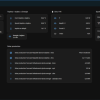Optimization of the operation of a photovoltaic-powered boiler with auxiliary heating from the distribution grid
Technology description
| The name of the technology: | Optimization of the operation of a photovoltaic-powered boiler with auxiliary heating from the distribution grid |
|---|---|
| Challenge: | With rising electricity prices and increasing pressure to reduce greenhouse gas emissions, a growing number of households are turning to renewable energy sources. In this context, photovoltaic systems present a promising solution, as they offer partial energy independence and long-term operational cost savings. However, their efficiency is not always optimal. My motivation was to enhance their performance in order to reduce reliance on the distribution grid. |
| Description: |
The technology is designed to optimize domestic hot water heating using a photovoltaic (PV) system. At the core of the system is intelligent control of the water heater via the open-source platform Home Assistant, which integrates various devices—such as temperature sensors, power meters, Wi-Fi smart plugs, and the inverter—into a unified, automated ecosystem. The key innovation lies in evaluating real-time water tank temperatures and forecasting solar energy production. Based on this data, the system determines whether water heating should be powered by solar energy or supplemented from the electrical grid. A unique feature of the system is its ability to detect the source of energy supply by analyzing total harmonic distortion of voltage (THDU), which makes it possible to distinguish between photovoltaic power and grid electricity. The advantage of this technology is its ability to increase the utilization efficiency of generated solar energy while reducing grid consumption—without compromising user comfort. The control system employs a GETI GWH01 smart regulator with MPPT (Maximum Power Point Tracking) technology, ensuring efficient tracking of the panels’ operating point. The Home Assistant platform enables advanced automation based on real-time data and solar production forecasts. As part of the project, a set of automation rules was developed to respond to current water tank temperatures, household power consumption, and solar energy forecasts retrieved from the Forecast.Solar service. The system also includes an SMC 144 measuring unit, which monitors electrical parameters via Modbus TCP communication. Temperature monitoring is carried out using sensors connected through a One-Wire bus. |
| Commercial opportunity: | The solution is commercially suitable for households, businesses, vacation properties, and similar facilities seeking to reduce their domestic hot water heating costs. |
| IP protection status: | Software (Copyright Protection) |
| Development status: |
Phase 3Corresponds with TRL 5 and TRL 6 Technology validation and implementing it in real environment. Testing the technology outside of the laboratory and its adjustment to external conditions.
|
| Partnering strategy: | Collaboration licensing |
| More information: | http://hdl.handle.net/10084/156954 |
| Images: | |
| Categories: | Software Information Sciences and Math |
| Institution: | VŠB – Technical University of Ostrava |
| Owner of a technology: | Vysoká škola báňská - Technická univerzita Ostrava |
